Nick and Helen Young are retracing the escape of his father, Leslie, from Fontanellato PoW camp, near Parma, after the Armistice with Italy on September 8th 1943. Their journey, undertaken in autumn 2017, is by car in three stages. As they travel south to Anzio, their final destination, they leave letters in the villages where Leslie hid, thanking the local people for sheltering him and risking retribution from the Germans and Fascists. Their journey is full of heart-warming and emotional incidents.
DAY SEVEN
When the chipper New Zealander Charlie Gatenby met up with my father and his fellow-escaper, RAF officer Reg Dickinson, in San Benedetto in Alpe, on Saturday 16th October 1943, he had already been on the run, on his own, for three weeks. He had escaped from the prison hospital at Modena, hidden in a rubbish cart after the Camp had been taken over by the Germans, and had made his way south with a serious leg wound and with just a pair of gym shoes on his feet. 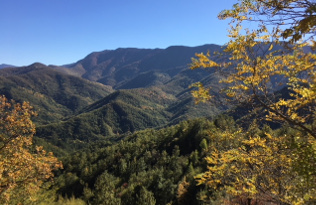
Gatenby and Dad clearly saw, in each other, kindred spirits, and their talk quickly turned to how best to make faster progress south. Dad and Reg had walked about sixty miles together since leaving Fontanellato, moving by day, keeping to mountain tracks, and aiming to sleep in a different place each night. They had kept going despite days of torrential rain, but their progress south had been slow, and Dad was showing signs of impatience with Dickinson’s more cautious (or more relaxed) approach. He quickly began to appreciate Gatenby’s robust and energetic attitude to the task of getting home. Winter was approaching, and every day there seemed to be more Germans about. Time was passing…
Having spent a couple of days sheltering from the rain in a cave, in the company of a rather wild band of partisans, the three were glad to be on the move again, fortified by a stolen turkey cooked over a fire the night before.
Their first stop as a threesome, in pouring rain, was Castel dell’ Alpi, a small hamlet of four small stone houses and a church, half way up a mountain in a clearing in the beech woods. 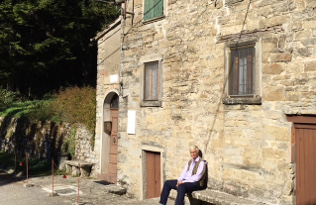
As we drove up 74 years later from the walled town of Citta di Castello, about 45 miles to the south, the autumn sun was shining bright and warm. We sailed along stunning river valleys, through veritable cathedrals of beech trees shading the road, past neatly ploughed fields, and tapestries on the hillsides in shades of yellow, brown and green.
Dad was bitten by a dog in Castell, and had to make do with a poor billet in some straw with the animals. We did rather better, with an excellent pasta in nearby Cornolio, in the company of a generous padrone and a leather-clad Ducati biker, both very interested in our story.
But that was the end of our good luck for the day. The next three villages on Dad’s itinerary were Celle, San Paulo in Alpe and La Lama. Oh yes, said the Padrone – they’re just over that hill over there.
Well, that may be so, but after five hours of driving on narrow, dusty, cratered tracks, often clinging gingerly to the rock face on one side as chasms yawned on the other, we had still not found one of them.
Celle seemed to be at the bottom of a deep, dark valley – so deep that we chickened out half-way down, did a nine-point turn at a precarious 45 degree angle and struggled back up to the top.
San Paulo, by way of contrast, was on top of a 3,000 foot peak. More dust, more pot-holes, another nine-point turn in progress, when out of nowhere three cars came roaring down the track towards us. I managed to stop the third by edging our car into his path. “San Paulo, La Lama?”, I asked, pointing back up the hill the way they had come. “You Tedeschi?” they responded, suspiciously. “No, Inglesi”, I said, hoping it was the right answer. “Oh yes’ they said, “the road is fine. An hour later, we ground to a halt in front of a locked gate across the road. Another nine-point turn – maybe I should have said we were Tedeschi after all?
Finally, La Lama, idyllically located at the foot of an Alpine lake according to the map. This was serious National Park mountain country: often above the tree line, huge views in every direction, setting sun, deer leaping across our path. Bigger pot-holes, even more dust. Were we down-hearted? Oh yes we were, as we stared unbelievingly at another locked gate across the road.
We consoled ourselves with the thought that, only two hours away was a warm flat and a bottle of good red wine.
Coincidentally, the San Benedetto Alps weren’t my father’s finest hour either. Soaked through as usual, he got lost on the way to Celle, and quarrelled with Reg Dickinson when he got there; he struggled for ten hours up the long climb to San Paulo, had several nerve-rackingly close shaves with Tedeschi on the way, and was infuriated to find on arrival that Reg had lost their good Touring Club map; and then he became separated from the others on the way to La Lama and had to spend a night on his own on the mountainside.
Maybe tomorrow will be better? Don’t bet on it, I hear him say!
DAY EIGHT
All we had was the name of a hill – Colle Nella – but we found it right enough, marked on a walker’s map at 780 metres, and there at the top was a scruffy homestead, with three small terraced cottages and a strong smell of the large white Chianina cows that are so common in these parts. 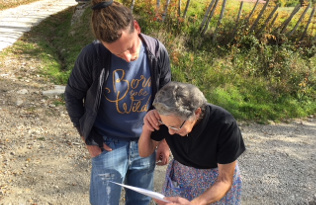
An elderly lady tottered out to see what we were up to, and studied a line or two of the “thank you” letter we are leaving wherever we go. “I only came here fifty years ago,” she said, “but I have heard the local stories of the brutta guerra”. My father noted in his diary that he was given a good lunch here and ten cigarettes, but that their host then put them on the wrong road – the little things that mean so much at times.
It was another perfect autumn day, and the view from the hill, of patchwork fields and turning leaves, tempted us to linger. But we pressed on, and came immediately to an unearthly landscape of stunted trees and cliffs of smooth cement – the Mountains of the Moon (Alpe di Luna). Soon, we were back again on a dirt road, nursing the car over startling fissures and hefty rocks at 5 mph. The German Gothic Defence Line ran through here, and one or two gun emplacements are still visible. 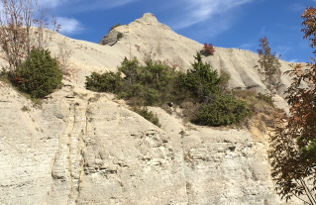
Lunchtime came and went before eventually we left the moonscape and came down into a pretty valley where we found a cafe on the grandiose piazza in Mercatello sul Metauro. A young nun fed the cats outside the nearby convent, giving us a shy smile before quietly closing the door behind her.
Then on to tiny Guinza, perched above another lovely valley, where we sat beside ruined cottages, all now deserted. There was no sign of the “good farm” where Dad found a bed for the night, but it must have been hard to move on the next day from such a peaceful spot. Once again, I found myself wondering why he never reminisced about the long journey he made through this majestic landscape. 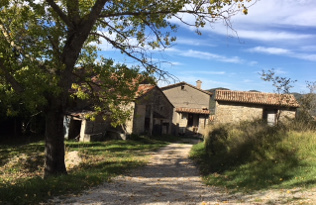
Bocca Seriola turned out to be a large cafe, much frequented by bikers, in a small clearing amongst the oaks and beeches. We pinned up a notice, and went for a short walk, returning to find a little group discussing it. We told the lady of the house that her predecessor had given Dad a map and a good meal. She smiled quietly to herself, as if to say “yes, that’s what we do” before returning to her book, about the “war on terror”. “Nothing changes,” she said, shaking her head.
Final stop of the day was a yellow ochre-walled town, set imposingly high on a hill above a wide plain. Pietralunga suffered damage in a recent earthquake, and the church is now unsafe and boarded up.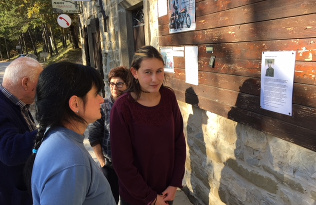
DAY NINE
After an early start, we had breakfast in the astonishing walled town of Gubbio, with its magnificent creamy palazzo dominating the valley below.
Above the town is a farm on a hill called Madonna della Cima – Our Lady of the Summit. Dad spent the night here on 26th October 1943 – in the rain, as usual. We stopped in bright sunshine at the pretty roadside shrine dedicated to the Madonna. “Oh passer by”, read the inscription, “pause and salute Mary, who will make the way safe for you.” It was a lovely spot, and we both had a strong sense of my father’s presence. 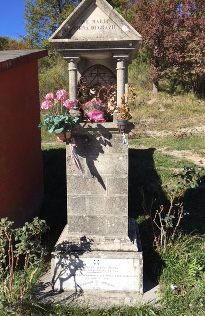
The farm itself is a big enterprise now, with huge metal barns for the cattle and purposeful machinery churning away. We knocked on the door and delivered our letter to the lady of the house – there were a few moments of nervous incomprehension, and then a nod and a smile of acknowledgement. She invited us in for a coffee, much as her predecessor must have done seventy-four years ago for three bedraggled ex-PoWs.
Then it was a twelve-mile drive for us down a wide open valley to the scruffy industrial town of Sigillo. Lorries pounded the main street, shaking the foundations of the self-important looking town hall, where we rather cheekily pinned our letter on an officious notice board. The town played a key role in Dad’s journey for it was here, after another grim day in the rain on rocky mountain tracks, that Gatenby admitted that, with his wounded leg and gym shoes, he was finding the going tough. He suggested that they should take a risk and use the roads, in order to make faster progress. Dad was all for it, but Dickinson was against – so the three decided to part company, with Dad and Gatenby leaving Reg to make his own way at his own pace. A tough decision.
With the 6,000 foot Serra Santa towering on our right, we drove on to Belvedere, a pretty cluster of pastel-coloured small houses surrounded by grassy slopes. But it seemed just a bit too manicured, and some online research revealed that the place had been devastated by an earthquake in 1997. The temporary huts used by the villagers while their homes were being rebuilt are still clustered in a rather haphazard way at one end of the village. Dad stayed at the church school here, evidently destroyed in the quake, and a local family “wept when we left”. 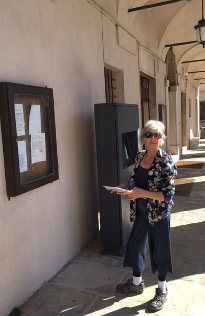
Finally, down a long, prosperous valley to prim, rather middle-class Bagnara. Dad and Charlie Gatenby were in good spirits by the time they got here, having walked 30 miles due south in the two days since they split up with Reg. They found a “good billet”, and were able to listen to the BBC. Thoughts of his parents at home in Epsom were in Dad’s mind, as he tried to think of a way to get a message back to them – they would have heard nothing from him since the Armistice.
DAY TEN
We took some time off yesterday, to visit the glorious Gran Sasso National Park and the tragic city of L’Aquila which lies at the foot of the Corno Grande, Italy’s highest mountain. The devastation is still very evident, eight years after the 2009 earthquake, with much of the central area still cordoned off, and the air full of dust and the sound of drills and cranes. It will be years yet before the city is fully restored.
Sadly, it was not just L’Aquila that has been affected by recent earthquakes, as was to become terribly clear as the day progressed.
Our first village today was Acquapagana, about fifty miles north of L’Aquila. It wasn’t marked on our main roadmap, so we made the mistake of relying on Satnav, which seemed sure it knew the way. The result was an hour or more struggling along dusty, rocky farm tracks at the instigation of the Satnav, listening to increasingly hysterical demands to “turn around when possible”, even though it was Satnav that had sent us there in the first place. A gruff farmer, high up in his massive tractor, eventually put us right, with many hand gestures and much shaking of the head, and we lurched back to the “main road”, itself little wider than the car. 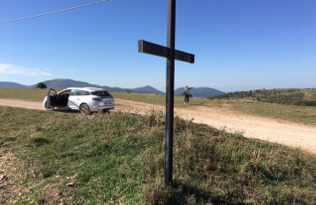
Eventually we came to the village, one of a string of small villages in a long fertile valley at the foot of Monte Cavallo. A ruined abbey gave us the first clue: deserted modern houses, piles of rubble where older houses had once been; wooden cabins for survivors awaiting rebuilding or as semi-permanent dwellings for the uninsured – here was another earthquake village, its plight unsung in the media, the life now squeezed out by the forces of nature.
Dad spent the night of 31st October 1943 near here, sleepless after a tricky encounter with a fascist-leaning Forest Guard. He and Charlie must have met up with another escaper, as Dad got news of friends from Fontanellato. They slept in the company of a group of “carbonari”, itinerant workers who lived in the forest burning wood to make charcoal for the fires of nearby villagers. 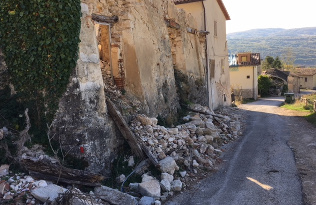
Fifteen miles further on, in the foothills of the Sibilline mountains, was Dad’s next stop, Ancarano, where he had another poor night after a “very long march”. They had decided to cut across country in order to make up some time, and found themselves stuck in beech forests where it was difficult to navigate, without food and only the company of some sheep for warmth: Gatenby “slept like a log, but the conditions were incredibly filthy and the stench something awful.”
Here too, the village seemed all but deserted, piles of rubble marking homes once full of life, a few houses untouched but shuttered and still. A few miles further on, in a wide flat plain encircled by mountains, we came upon the small walled town of Norcia, hit by a quake only last year, its ancient walls breached in many places, and a fine church in the main square now only a facade amidst a sea of broken stone. The town is famous for its pork, and one or two temporary stalls have opened up to sell meat to those who have remained, and to the groups of tourists, here to look and shake their heads sadly and helplessly.
Our hope for a more cheerful end to the day was Pescia, at the end of a four-mile track beside a stream in a pretty, narrow valley threading between golden autumn slopes. But the tiny square was ringed by small heaps of rubble, and populated only by several families of stray cats. A few houses had survived, but most looked tidy enough but empty now.
We could hear only the splashing of the stream through the original wash-house opposite the church – where we pinned our ‘thank you’ letter, and left the village to its ghostly residents.
DAY ELEVEN
Cesaproba is a large workaday village on the western edge of the Gran Sasso range of mountains. At 10 on a Saturday morning, there were few signs of life, but those who were stirring gave us slightly curious stares, quickly identifying us as “strangers”.
We realised that, for Dad and Charlie, this must have been a constant worry, in countryside far more heavily populated than it is today: Dad was described leaving Fontanellato by one of his friends as looking “for all the world like an Englishman poorly disguised as an Italian”. Both men were limping heavily, Dad having by this stage developed a very sore heel, and only Charlie spoke any Italian at all – and that with a strong New Zealand accent. They must have stuck out like sore thumbs.
Feeling slightly awkward, we decided to drive on when we spotted a tiny church with the door open. We left our thank-you letter inside the doorway and were just leaving when we were stopped by three local women, who eyed us curiously and said “Buon giorno” with a definite question mark at the end.
We told them our story and, after the usual few moments of confusion – “So you are Tedeschi?”, “Your father lived around here?” etc – we were soon on friendly terms and the centre of a growing crowd of people on their way to Mass, market traders trying to set up their stalls, the priest, mothers with their babies, and several dogs. It was all very jolly – such friendly folk, the Italians, keen on “family” of course and, in our case, delighted to be praised and thanked for once about something that happened during the war. 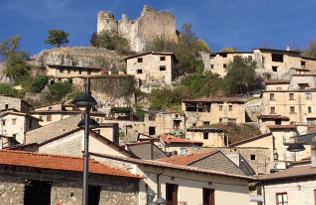
Driving on south we entered a busier, semi-industrial area, the villages closer together as we drew nearer to L’Aquila, and the dangers growing correspondingly greater for the two escapers. Geography had forced them down from the hills briefly, in order to cross the main road and railway line to Rome from the east coast. We found the heavily-guarded bridge that, according to Dad’s diary, they had had to skirt, and the place where road and rail came close together in a cutting and they were able to scamper across between passing German Army convoys.
It was as they were coming out of this patch, heading back up into the hills, that they came upon a village where, for the first time in nearly two months, they were refused food or shelter of any kind, and so they were forced to spend a night on the bare mountain.
In Lucoli, another mostly-deserted village nestling picturesquely into the hillside, they found a “reasonable billet” the next night, Dad grumbling about his painful heel. Then, in the morning, they began a frightful climb up and over the bleak 6,000 foot peak of Monte Cava which lay between them and the village of Corvaro for which they were heading, their route now taking them slightly west of south, hoping perhaps for news of another Allied landing north of Naples before winter set in.
Corvaro seems to flow down the mountain like lava. The old part, substantially destroyed in the terrible 1915 Avezzano earthquake, has been largely abandoned, and the village has sprawled onto the plain at the foot of the mountain. We paused only briefly, aiming to return after the weekend, but were held in conversation by Cristina, who works in the local museum and wanted to know who we were and why we were in Corvaro.
“Ah”, she said, her English excellent after a period living in Dublin, “our story gives me goose bumps. My grandfather was a PoW in England – I would love to know where. Perhaps you can help me work it out?’
DAYS TWELVE AND THIRTEEN
When my father and his fellow escaper Charlie Gatenby arrived in Corvaro on 6th November 1943, they were both pretty well done in. They had been walking in mountain country, with little to eat and mostly only barns to sleep in, for two months. Charlie’s wounded leg was playing up, and they both had sore, blistered and bruised feet.
They found their way to a small shop whose owner, Bernadina de Michelis, gave them a friendly welcome, and sat them down to a meal of ham and bread, a glass of wine and a pack of cigarettes. When her husband Peppino came in from the fields, it was agreed that they could spend the night with the family horse, in a grainstore in the rear basement of the house, the upper floor of which was also home for the couple and their five children. 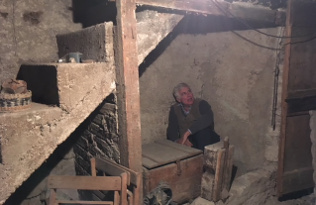
But by the next morning, my father had developed a raging temperature, and Bernadina insisted on sending one of the children out to fetch the doctor. Influenza/possible pneumonia was his verdict, and Dad was grounded and subjected to a course of extremely fearsome injections, administered by one of the young people, until he recovered.
He urged Charlie to continue on alone, in case they became snowed in for the winter, but the doughty Kiwi would have none of it. Sure enough, a few days later, it snowed heavily and the two men had to accept that they would be unable to make further progress south for weeks, if not months. Their hopes of being “home by Christmas” were in ruins. 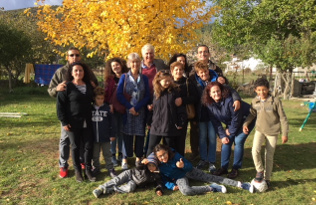
The family de Michelis didn’t turn a hair, despite the fact that Corvaro’s substantial German garrison was literally seventy-five yards down the road. The men were rehoused in a small barn at the rear of a nearby house and, as soon as Dad had sufficiently recovered, were then moved again into a small stone shed in a deep wooded canyon called the Valley of the Bandits, about five miles from Corvaro. Three other escapees joined them there, and Peppino and his son Toto brought the men occasional supplies, under the very noses of the Germans, in a cart pulled by their erstwhile sleeping companion, the horse. 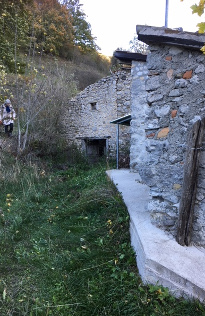
And there they stayed, eight feet of snow on the ground.
Seventy-four years later, Helen and I spent the last two days of our trip with three of Peppino and Bernardina’s grandchildren, Santini, Biancamaria and Giuseppe, their mother Lilia, and their own eight children. It is hard to describe my feelings about spending time in the company of a family to whom, quite literally, I owe my life. We have been in contact for a few years now, and have visited Corvaro once before, but still the feeling persists that this is part of my family too, and that we are part of theirs.
With their children gathered around, we told the story all over again, of Peppino and Bernadina, and Leslie and Charlie, and we cried for sheer wonder at the bravery and determination and serendipity of it all.
They showed us the shop where Bernadina gave the escapers bread and ham, and the cellar where the men slept with the horse, and the grain store they hid in when the Tedeschi came to call; we walked up into the Valley of the Bandits where the men spent the next two months, chopping firewood and walking in the hills to keep warm; we wondered at how close was the German garrison; and talked of the remarkable parish priest Don Filippo Hortense who had urged his congregation to remember the parable of the Good Samaritan – with the result that the parishioners looked after more than 100 ex-PoWs in Corvaro that winter.
We also mourned the recent death of the children’s father Toto, who remembered, as a little boy, sitting on my own father’s knee during an Allied air-raid and being fed peppermints from Dad’s lifelong limitless supply; and we met Toto’s lively 87-year-old- elder sister Luigina, who vividly recalled how Dad loved to play with the children, and gave her her first English lesson at the kitchen table, and how Peppino had to chuck the give-away papers quickly onto the fire when a German soldier knocked on the door.
We received a municipal welcome at the local museum, devoted to the spectacular contents of a ninth century BC tumulus, and gave an interview to the local press.
And we talked and talked and, when Giuseppe’s Roman partner Gianna could interpret no more, we simply waved our arms about and just talked a little louder! And of course, we ate mountains of Mama Lilia’s delicious pasta and her scrumptious cakes. It was a wonderful two days, and we hated saying goodbye, and heading off to the airport.
*********
Thank you for reading this Blog. You may be interested to know that I have already received nearly twenty responses to the “thank you letter” we have been leaving in the villages we have passed through, and hopefully these will generate increased interest in the amazing story of how countless poor Italian farming folk helped save the lives of thousands of Allied escapers: perhaps also a few more applicants for the Monte San Martino Trust’s English bursaries?
We return to Italy in November, to follow the last stage of my father’s route, to Anzio, where he hoped to re-join the Allied forces as they battled to secure the beachhead against relentless German attacks and bombardment, a few days after the invasion force had landed.
We will try to make sense of the enormous risks the men took as they crossed the German and American lines and minefields, and we will be thinking about another family, the Elfers, who were in Bernadina’s shop that first afternoon when Dad and Charlie stumbled in off the mountainside –another family to whom my father owed his life, and to whom I owe my very existence. But of that, more anon…..
A presto!